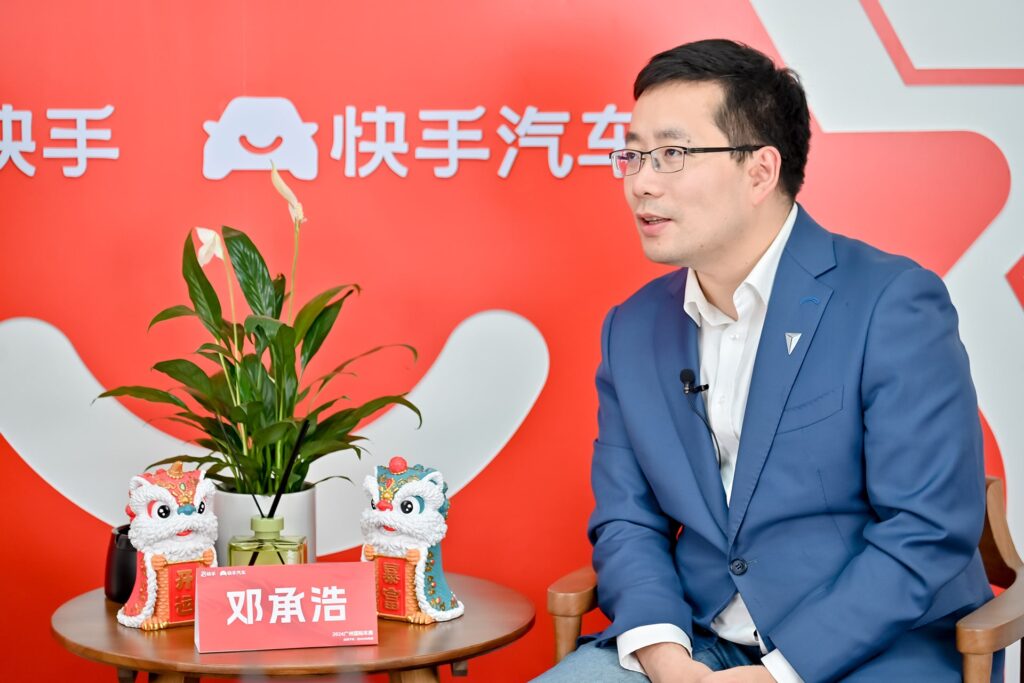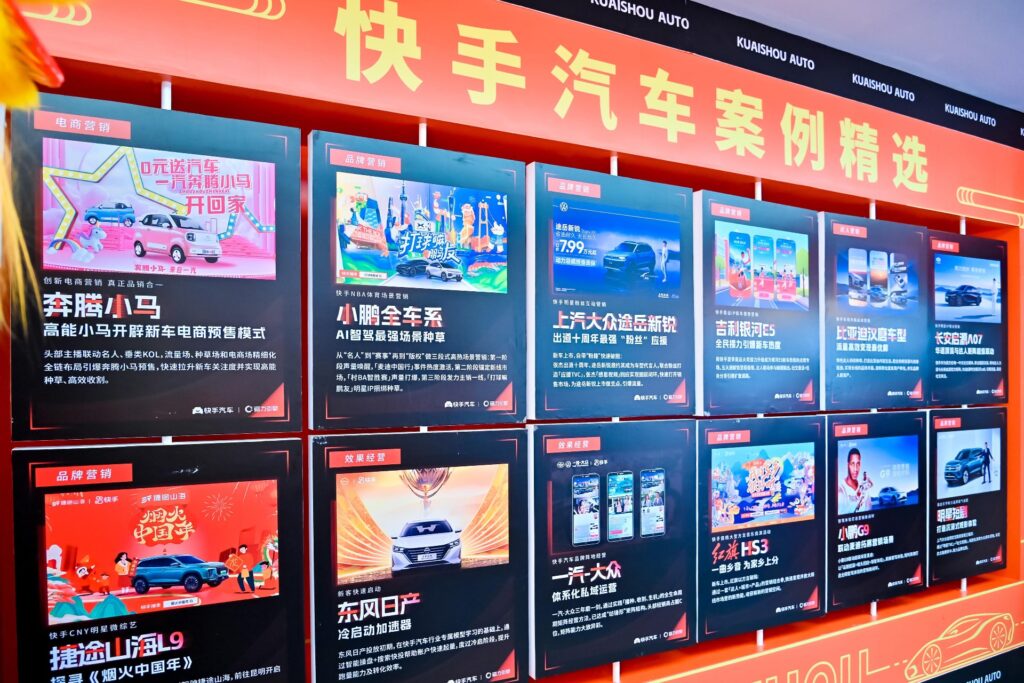Automakers make digital pivot as focus shifts to online sales

Platforms like Kuaishou are giving carmakers new ways to engage buyers and boost sales in an increasingly competitive market.
The automotive industry’s landscape is becoming increasingly intricate.
In 2024, as consolidation and repositioning dominate the industry narrative, automakers have come to terms with reality and shed their pretensions. From merging subbrands to restructuring product portfolios, live streaming directly with car company CEOs, expanding online channels, and more, the variety of strategies highlights a common pursuit: everyone is trying to identify the next stable growth driver.
Automotive shows have always served as a window into the industry’s trends. At Auto Guangzhou, seen as the year’s final battleground for carmakers, intriguing developments are emerging.
During the event, several car dealers shared that around half of their sales come from online sources. Ever since new electric vehicle players redefined the market with online-first models, the automotive industry’s digital transition seems to have accelerated. At the show, nearly every automaker’s booth had live streamers with equipment in hand. Most of these streamers, however, were also car dealers representing the brands they streamed about.
Interestingly, while online leads generate significant traction, the transactions themselves often still occur offline. Unlike retail industries reshaped by e-commerce, the automotive industry has seen slower adoption of online-only sales. Big-ticket purchases are rarely made in isolation, as buyers typically visit showrooms before finalizing their decisions.
Yet, the fact remains: dealers immersed in the market’s competitive heat are increasingly investing efforts in online platforms.
Online channels hold sales potential
The automotive industry has started to recover.
According to the China Association of Automobile Manufacturers, between January and October this year, vehicle production and sales reached 24.47 million and 24.62 million units, reflecting year-on-year increases of 1.9% and 2.7%, respectively. Notably, production and sales of new energy vehicles (NEVs) surged by 33% and 33.9% during the same period.
These figures highlight the industry’s revival, driven by NEVs. However, a return to its former glory remains uncertain. The entry of new players has made the market crowded, while consumer demand hasn’t expanded significantly. In a relatively fixed market, automakers are fiercely competing on products, technology, services, and price.
In reality, the industry’s recovery has come at the cost of automaker profits, with price wars being a key driver. Data from the China Automobile Dealers Association reveals that the sector’s profit reached RMB 336 billion (USD 47 billion) in the first three quarters, a 1.2% year-on-year decline.
Facing profit squeezes, automakers are eyeing two clear growth paths: seek new opportunities in overseas markets, or compete aggressively within the domestic market.
The competition for market share in China is revealing emerging trends. With car ownership in the hundreds of millions, demand remains stable, driven by shorter vehicle replacement cycles. The real challenge isn’t the absence of buyers but the ability to identify and engage potential ones.
For decades, whether in times of boom or bust, the core of automotive sales strategies has been consistent: finding leads and converting them into customers. From collaborating with automotive media to creating viral marketing campaigns on social media, brands have always followed one principle—go where the customers are.
“Shifting automotive marketing to new media is essentially a change in how we find leads,” said Feng Fei, assistant to the general manager of BAIC Motor’s vehicle sales arm, during a panel discussion at Auto Guangzhou co-hosted with Kuaishou’s automotive division. His comment reflects a larger industry reality: the shift from “people looking for cars” to “cars finding people.”
The relationship between users, products, and platforms is undergoing a profound transformation. Content platforms are at the forefront of this change, with automakers recognizing their value. Data from Kuaishou’s 2024 white paper on the automotive industry indicate that short video platforms will command the highest share of marketing budgets from automakers in 2024, with a projected growth rate of 9.6%.
This shift has fundamentally redefined dealership operations, with content teams now a standard feature within dealerships. Deng Chenghao, vice president at Chang’an Automobile, said that embracing new media isn’t about chasing trends but about adapting to change and equipping teams for a new era.

Content platforms offer a more nuanced and strategic approach to marketing. “The industry has entered a fiercely competitive era. Instead of relying solely on traditional advertising, original equipment manufacturers (OEMs) are placing greater trust in new media platforms to manage their presence and cultivate customer engagement,” said Wang Qiufeng, head of Kuaishou’s automotive division.
Managing online sales infrastructure
Automakers embracing new media and content platforms is no longer groundbreaking. Live streaming by founders and executives, combined with the growing sophistication of automotive content ecosystems, highlights the acknowledged value of these platforms in driving both traffic and visibility.
The idea of creating “digital showrooms” has gained traction, but many automakers remain anchored to the old logic of “people finding cars.” While brands have launched official accounts, posted car videos, and engaged influencers, these efforts often recycle traditional marketing strategies, treating platforms as mere channels for ads.
The underlying issue lies in defining the industry’s primary “battlegrounds.” Traditionally, 4S dealerships served as the main touchpoints between brands and consumers. For emerging EV players, two distinct strategies have surfaced: establishing proprietary stores and service centers, or building closed-loop ecosystems online via proprietary apps and mini programs.
While these approaches prioritize lead conversion, service delivery, and after-sales management, some new entrants are testing innovative models, such as placing stores in mixed-use complexes to merge sales, service, and brand visibility. However, high operational costs and limited scalability confine such experiments to top-tier cities.
As margins shrink and budgets tighten, automakers’ expectations have evolved. They now demand comprehensive solutions that offer increased brand exposure, higher-quality leads, and improved in-store conversions. These mounting pressures are driving brands to explore new and innovative pathways.
Earlier this year, 36Kr reported on Haval’s experiment of onboarding dealerships onto Kuaishou. Within six months, this strategy generated approximately 120,000 leads and closed 780 sales. Half a year later, scattered efforts from various automakers and dealers are consolidating into an ecosystem. Platforms like Kuaishou are emerging as comprehensive options, offering integration with offline sales channels and yielding positive results.
Kuaishou’s automotive ecosystem has thrived in 2024, with content production by brand and dealer accounts increasing by 39% year-on-year, driving a 195% surge in lead generation. For instance, FAW-Volkswagen generated over 1.94 million leads in the first half of the year while keeping the cost per lead below RMB 20 (USD 2.8)—an exceptional achievement in today’s fiercely competitive market.
These numbers underscore the growing recognition of platforms like Kuaishou as pivotal digital battlegrounds for the automotive industry. Currently, more than 120 automakers’ official accounts and around 27,000 dealership accounts actively engage users on Kuaishou through short videos and live streams. Dealer participation has risen by over 20% compared to the previous year, marking a significant shift in how the industry connects with its audience.
Kuaishou embraced this trend by unveiling a comprehensive “digital battleground” solution during Auto Guangzhou, positioning itself as a one-stop platform for automakers to meet evolving market demands. According to Kuaishou’s Wang, this solution is set to become essential commercial infrastructure for the automotive industry.

In an era of shorter decision-making cycles and heightened competition, the shift from “people finding cars” to “cars finding people” has moved from being optional to a necessity. Kuaishou’s roadmap places dealer and brand accounts at its core. The platform also provides integrated backend solutions such as data synchronization, tailored advertising tools, artificial intelligence-driven lead targeting, and closed-loop conversion tracking. These features support its broader vision of becoming a cornerstone in automakers’ digital strategies.
For example, Hongqi recently ran a high-profile IP campaign on Kuaishou. The campaign generated massive exposure, enabling users from Hongqi’s official and dealer accounts to be segmented into actionable categories, from casual viewers to test-drive-ready prospects. Kuaishou’s backend tools allowed Hongqi to track the customer journey, optimize engagement strategies, and reduce redundant targeting, maximizing efficiency while cutting costs.
Meanwhile, Kuaishou continues to fine-tune its infrastructure in two key areas:
- Traffic infrastructure: The platform has fully adopted demand-side platform (DSP) bidding, significantly enhancing targeting precision. Tools like “universal auto ads” (UAL) improve traffic reliability, while centralized advertising tools give automakers greater control over managing dealer accounts.
- Product infrastructure: From robust lead generation entry points to advanced audience-cleaning tools and backend management capabilities, Kuaishou’s comprehensive suite of solutions helps automakers streamline operations and boost efficiency.
One of the most notable shifts is in how automakers evaluate platforms like Kuaishou. Traditionally, metrics such as cost per sale (CPS) were the primary benchmarks. Now, cost per lead (CPL) and a platform’s alignment with broader business strategies are taking precedence.
“CPS is important, but it can’t be the sole measure of a platform’s value,” said Wang. Kuaishou is investing heavily in developing third-party ecosystems to offer copiloting and operational services for both brands and dealers, working toward building a collaborative and resilient digital future.
Kuaishou’s solution is also fostering a more dynamic relationship between automakers and their dealerships. Through integrated backend data, brands gain greater insight into dealership operations. This enables flexible pilot programs, centralized ad budget management, and performance-based incentive distribution.
Content platforms are emerging as the primary gateways for traffic in the current market. While Kuaishou stands as a strong contender, it won’t be automakers’ sole option. However, Kuaishou’s distinct advantages are difficult to ignore.
According to its latest data, Kuaishou’s daily active users (DAU) now exceed 400 million, with sustained growth. Among these, over 200 million users show interest in the automotive industry, providing a robust and stable base for automakers. Additionally, Kuaishou boasts a unique edge: exclusive access to over 46 million automotive-focused users who do not overlap with competitors’ platforms. Compared to niche automotive media, Kuaishou grants automakers access to untapped potential, creating fertile ground for new opportunities.
Kuaishou’s true strength lies in its reach across emerging markets. A significant percentage of its new users are noted to express interest in automotives, and this audience isn’t limited to specific regions but spans the entire country, with over 40% of them concentrated in northern and eastern China. In a saturated market where brand recognition is waning, the first automakers to effectively embed their messaging into these new audiences will secure a decisive advantage.
The rise of NEV brands through online platforms has opened new possibilities for the automotive industry, but not all automakers have transitioned smoothly. Many remain at the starting line, while others have leveraged platforms like Kuaishou to their advantage.
The question remains: Will the early adopters—the risktakers who pioneered these strategies—continue to lead, or will new trailblazers emerge to take their place?
#AutomotiveIndustry #LiveStreaming #NewEnergyVehicles #DigitalMarketing #Kuaishou


- Art
- Causes
- Crafts
- Dance
- Drinks
- Film
- Fitness
- Food
- Games
- Gardening
- Health
- Home
- Literature
- Music
- Networking
- Other
- Party
- Religion
- Shopping
- Sports
- Theater
- Wellness


